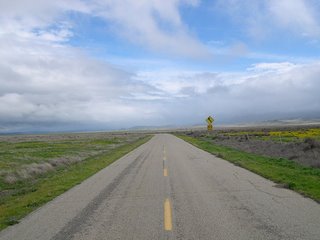
Ben was by the Dairy at 8:00 in order to show me how to do the Sunday routine. It involves scrubbing moulds, turning cheeses, labeling them and putting them away to rest. Then moulds are transferred into barrels full of a mild acid in order to de-scale them. Some moulds go in one barrel, others get rinsed and go into another. I'd better make sure I know which is which, because next week I fly solo.
Ben took off before 9:00AM to go to the Tavistock Cheese Festival. I was left to my own devices. I had to do wash the white lab coats for the week and then I was free to go and explore the area.
I had picked up some leaflets at the Totnes Tourist Information office on Thursday. One of them listed guided walks around the South Hams area (this part of Devon.) A walk was leaving at 10:30 from the TI. It was called Totnes' hidden highways, lead by Valerie Belsey. Ms. Belsey published a book called "Exploring the Green Lanes of the South Hams." This three mile walk followed old paths that run between the hedgerows, and have since the Saxons used Totnes as a trading center. There were twelve of us and two dogs on the walk. Valerie explained the that these lanes were used by drovers, taking their livestock to market, as well as peddlers, soldiers, and thieves. Large oak trees were used as landmarks along the paths because they are visible above the hedgerows. The paths definitely go from tree to tree. At the farthest point on our walk, we stopped and took in the panoramic view of Totnes, the castle at Berry Pomeroy, Hound Tor on Dartmoor, and several other villages. We were taught how to date a hedgerow. Count the number of plant species in a thirty yard stretch of hedge. Each plant species equals 100 years in age. In our demonstration section we counted seven different plants. This hedge was probably 700 years old. The lanes are sometimes paved roads, sometimes unpaved tracks, or part of developed trails. They are all over the countryside, especially near market towns like Totnes. We ended our walk at 12:30 back at the TI. Just in time for lunch! It's Sunday, so most places are closed. I found a pub called the Barrelhouse that was open. One BLT and cuppa tea later, I felt refreshed and ready to head back to the dairy. It was bright and sunny. The perfect weather to take an afternoon nap.
I picked up a booklet at the TI the other day. It's called "Clotted Cream" by Carolyn Martin. It is thirty-two pages about the history, use of, and preparation of clotted cream. Nothing goes better with pie than a large dollop of clotted cream. It has a fat content of over 55%! It's heavier that heavy whipping cream. It's thicker, too. If made in the traditional way, it is left to sit overnight in a shallow pan and then cooked gently in a water bath for a couple of hours or until a thick crust forms. I have been resisting bringing some home. It is so good on fresh berries. Channel Island milk is recommended. This means getting milk from Jersey or Guernsey cows. 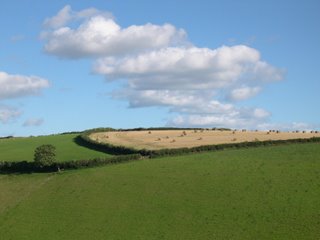
Wednesday, August 30, 2006
Walking the Green Lanes
Posted by
Sairbair
at
8:50 AM
0
comments
![]()
Labels: Ticklemore Cheese Devon England
Cheese Duties begin: Tavistock and cheese turning

Had to get up early on Saturday in order to prepare for the Tavistock Cheese Festival. The local cheese shop, Country Cheeses, invited artisan cheese producers from all over southwest England to come and promote their wares and offer samples to the eager public over the Bank Holiday Weekend. Ticklemore normally doesn't participate in these promotional events, but the owners of Country Cheeses are friends of Robin, so he agreed to send some cheese and the staff of Ticklemore to participate in this gathering. Nick showed up at the dairy at 8:00am. We grabbed some knives, cutting boards, plastic molds wrapped in gold foil as dummy display cheeses, and off we went in Nick's rickety old Land Rover. We bounced and rattled west across Dartmoor. Dartmoor is a National Park that consists of ten tors (Celtic word for hills,) sweeping views, bronze age cairns, stone circles, stone huts, hill forts, countless other archeological sites, and a high security prison. We raced passed standing stones that went unnoticed by Nick. We had to slam on our brakes to avoid hitting a group of Dartmoor ponies. Apparently these small ponies are seen as vermin. They wander across the moors and live wild like the mustangs of the American west. Occasionally the locals round up a bunch of them for auction. Those that don't find homes meet an unfortunate fate.
After 45 minutes of driving, we arrived on the western side of Dartmoor in the village of Tavistock. It is market day around the huge, stone town hall. The local, Dartmoor granite seems to be the building material of choice. All of the local buildings are constructed of this dark grey stone. The town hall is an impressive Victorian three storey building with a large hall on the second floor. We were escorted to a table at the far end of the room where we set up to offer tastings of Devon Blue (cow's milk), Harbourne Blue (goat's milk), Beenleigh Blue (sheep's milk), and Ticklemore Goat. We didn't have any big, flashy display material, nor leaflet to hand out. Our set-up was pretty basic. Nick grumbled about how he really wanted to leave early to catch the Red Arrows' airshow back at Dartmouth. He's not a fan of these promotional appearances. They can be quite draining, answering the same questions, and being cheerful for many hours. I found it to be quite easy, it was like any busy Saturday at Cowgirl Creamery. The constant stream of cheese fans were happy to try all of our cheeses and then head over to the sales counter to purchase some to take home. 
Here is Nick Trant, Ticklemore Cheesemaker offering our cheese to the eager masses. Standing to his right is Kim from Gorwydd Caerphilly.
We were set up with a Green's Cheddar from Glastonbury and Trethowan's Gorwydd (pronounced Gor-with) Caerphilly. Green's cheddar was pretty acidic. I didn't like it. I am very familiar with the caerphilly that Kim and Maugan Trethowan were sampling. Cowgirl sells their cheese. It's a wonderful, traditional Welsh cheese with a bright, lemony flavor, a softer outer layer and a more firm, but moist center. Kim is originally from New Zealand and used to work at Neal's Yard several years ago. She's in charge of maturing the cheeses. Her husband Maugan (Cornish name pronounced Morgan) is the cheese maker. They make their cheese in western Wales on a farm that they share with Maugan's brother Todd. Kim and I hit it off right away. She was really curious about my quest to make cheese at Ticklemore. "Oh, you picked a good one," she said. "I just love all of their cheeses." I couldn't agree more. Funny thing, I had contacted Gorwydd Caerphilly to see if I could spend some time with them this summer. They sent me the kindest rejection letter that I've ever received. No regrets. I'm exactly where I want to be.
I ran into someone I knew at the event. Tom Calver was there, representing Westcombe Dairy. It was great seeing him. He had an impressive display of several wheels of cheddar and Westcombe Red. He was set up with the other two artisan Somerset cheddar producers, Montgomery's and Keen's. I was slightly in awe to be across the way from Steve Bridges, the cheesemaker at Montgomery's cheddar and George Keen of Keen's cheddar.  The cheddar men, Tom, Steve and George.
The cheddar men, Tom, Steve and George.
Comment of the day: "Goo-ah! Thaht's ah luhv-lee cheese!" uttered by a short, portly fellow in a stained, red jersey and blue shorts. I'm still trying to figure out just what "Go-ah" stands for. Is it "Go on!" "God!" "Good!"??? All I know is it's a sound made when you're really happy.
Other phrase I heard repeatedly: "It's a moorish cheese!" In other words, it's a cheese you can't stop eating. You want more of it.
Long day. We left when we ran out of cheese around 3:30.
Villages we passed on the way home via Plymouth: Leg 'o Mutton, and just down the road was Crapstone. Nick says his sister-in-law lives in Middlewallop. I just love English place names.
Saturday evening. My first cheese duties begin! I get to turn the day's cheeses. Fourteen Harbourne Blues were waiting for me in the Making Room. Each cheese gets flipped in its mould so it drains evenly. Its kind of like tucking 'em in bed for the evening. You want to make sure they're comfy and happy. I donned my green rubber wellies (boots,) grabbed a hairnet, chefs pants, a lab coat, an apron and gloves, scrubbed up as if preparing for surgery, an entered the Making Room. The cheeses were set up on a table with a milk can underneath the hole at one end to catch the whey as it runs off of the cheese. I grabbed an empty mould and set it on it's side with the open end away from me. I set the first cheese on it's side so the molds were facing each other. Then I carefully tilted the cheese up and it slipped right into the empty mold. Viola! Turned cheese! I tackled the thirteen others, placed the now empty moulds in the sink to wash in the morning, and locked up for the night. I am officially a member of team Ticklemore.
Posted by
Sairbair
at
8:37 AM
1 comments
![]()
Labels: Ticklemore Cheese Devon England
Monday, August 28, 2006
Friday, August 24th, Dartmouth
Friday
Sarie arrived and we heaved my heavy luggage into the Ticklemore delivery van. This white van looks innocent, but I'm not fooled. It is to be my chariot while I'm here. It is a small Citroen two passenger van with a manual transmission. Oh God. Not only do I have to drive this thing on the other side of the road, but I have limited visibility behind me and I have to shift with my other hand. And the mirrors are in the wrong place, too. Oh boy. I won't be leaving the dairy much, I think. But now we are grabbing some things to take up to the dairy before they leave for Spain in a couple of hours. It is Friday, and that means market day in Totnes. Markets are held in many towns all over the U.K. and Europe. They are a combination of flea market and farmer's market. Cheap socks, tasty pastries, and fresh carrots all in one place. Yippee! Sarie and I grabbed some bread for sandwiches, I snagged some green gage plum preserves (heavenly), some raspberries, apples, and eggs. Enough stuff for me to make some weird meals.
Robin and Sarie pack up their car and off they go to Plymouth to pick up a ferry to Brittany. I unpack and settle in. Nick and Liz are working in the dairy today. They keep popping in and out of the front room. Time for tea, lunch, etc. Essentially, I am staying in an apartment tacked onto the dairy. It's sort of like an illegal inlaw unit. When Robin built the place, he was granted permission for the industrial use of the property, but not the residential. That has since been rectified, but it hasn't been improved much since it was built. The main living area is also the employee lounge. Everyone comes and goes all day, the door is always open. The bedroom is off of living room/kitchen. There are stairs leading up to the den where there's a sofa, chair and bookcase. The bathroom is also up here. As is the airing cupboard. The bathroom has a large bathtub, sink and toilet. No shower. Damn. There is a hose to rinse with, attached to the faucet. How am I supposed to wash my hair? This is going to be a challenge.
Staying in someone else's home is a strange way to get an intimate glimpse into the lives of others. It's strangely voyeuristic. Things I take for granted at home are not here. They have a washing machine but no dryer. They have a slow, Dial-up modem, not DSL. They have a refrigerator the size of a large dorm fridge. There are no condiments like ketchup, mayonnaise, Tobasco. I can't find a frying pan or tongs. It is sort of like stepping into someone else's life, but they don't seem to cook much. I'll be on the look out for frying pans at the local thrift stores.
Nick has invited me to follow him to Dartmouth to see the Dartmouth Regatta. It's a weekend full of rowing races, a carnival, Navy displays, fireworks, fishing derbies, and an air show by the Red Arrows (UK version of the Blue Angels.) Dartmouth is home to the Royal Navy Academy and it is full of old, Tudor style buildings and fudge shops. Big tourist town. We take the long way around from Totnes to Dartmouth, sticking to the major roads instead of driving down "the lanes." It is so easy to get lost down the lanes. I am happy to take a few more minutes driving in order to avoid dodging oncoming traffic in the narrow, windy single track back roads. People drive like maniacs down these narrow roads that are seven feet wide, if you're lucky. Every turn is a blind curve due to the hedgerows. It is a wonder that there aren't more fatalities on these roads. They really scare me.
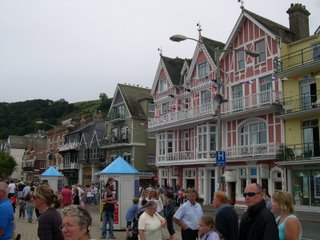 Photo: Dartmouth
Photo: Dartmouth
Nick lives in the next village beyond Dartmouth, so we park our cars there and carpool in to town. He's picking up the family, so I am left to my own devises. I stroll down along the quay, watching the crowds and the boat races. There are several rowing contests going on and there is a loudspeaker calling the gripping action on the river. The smell of grilled sausages and cotton candy is overwhelming. The carnival dominates the center of the festivities. There are hundreds of people packed onto the quay. Not only are people watching the boat races, but there is a crab derby going on. People of all ages are holding spools of kite string with bacon fastened to the end of the string. They lower the bacon into the water, wait a minute and pull up the bacon again. With luck, there is a small crab clinging to the greasy pork product. It's about 15 feet from the water to the top of the cement quay wall. Half the time, the crabs let go and plunge back into the murky water. Kids are lined up and down the quay, with string in hand and a bucket of water at their feet for their catch. They're reeling the crabs in, fast and furious. The crabs are about the size of the palm of your hand. They're small. The English don't eat them, but the get shipped off to France and Spain where they're considered a delicacy.
As I watch these young teenagers playing with the crabs, I call Jim. A 14 year old boy hears my conversation and starts talking to me. He offers to let me have a go at crabbing. I get off the phone with Jim and have great success. The crabs can't wait to get my bacon. It barely hits the water when there's a crab on it. Amazing. This kid named Marcus is fascinated by my accent and the fact I'm from California. No, I don't know any movie stars, I've seen a few. He asks a million questions. Someday he hopes to go to America, but first he wants to visit London. He's from Bristol. His family has rented a house nearby and they're spending the week in Dartmouth. Nice kid.
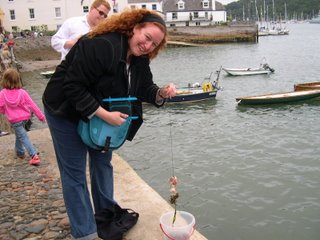 Photo: I caught a crab in Dartmouth!
Photo: I caught a crab in Dartmouth!
I quit fishing for crabs and bid Marcus and his friend Haley farewell. I head back to the bus stop and catch the #93 back to Nick's house in Stoke Fleming. It's drizzling and I'm tired.
Nick's house is a beautiful 18th Century home that's on several floors. It's actually three old cottages that have been joined together. He's got three kids, so he needs the space. Nick and his wife Sally love to cook. They used to own a bakery in the village, but gave it up due to the hideous hours and slow business. They have a great kitchen, full of equipment for baking and whipping up good meals. He's made some sausages and offers to give me a few. I head off, retracing my steps back to Totnes. Sausage for dinner. Amazing, nicely seasoned, and perfect. They go well with my fresh corn.
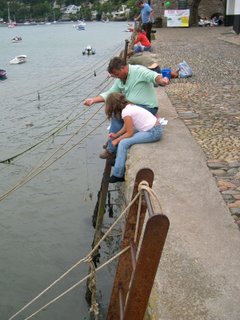
I miss my DSL....
Posted by
Sairbair
at
2:35 PM
1 comments
![]()
Labels: Ticklemore Cheese Devon England
Tickle me Ticklemore

Breakfast at the Steam Packet Inn. I awoke to a bright and beautiful morning. I struggled with the Power Shower in the bathroom. These things always confuse me. They're flash water heaters, so they usually scald me at first before I get the temperature right. This one proved to be no different. Plus, the shower was a hose attachment that runs off of the Power Shower unit and proved to be fairly inflexible. Then I was faced with the challenge of keeping the water confined within the bathtub. Showers are not as common as bathtubs around here, but people have been trying to make do with what they have. All over the U.K., I have found bathtubs rigged with half a glass door sticking out from the wall and only extending about two feet along the outer rim of the tub. So you're not entirely enclosed. The rest is open to the room. So if you manage to yank the showerhead hose off of its perch, you must be very careful not to get the floor, toilet, toilet paper and towels wet. My success rate is about 60% right now. I only go the floor slightly wet with this one.
All clean and ready to face the day, I enjoyed a huge breakfast in the sunny, riverside breakfast room. The tide was high, so the river was beautiful. A couple of people mentioned that these are the Spring Tides. Twice a year, they have especially high tides so the river looks really impressive. The inn served a beautiful breakfast with your choice of oak smoked haddock and eggs, smoked salmon and eggs, or the full English breakfast: sausage, bacon, blood pudding, sautéed mushrooms, cooked tomatoes, fried bread, toast and three eggs cooked any style. OJ, coffee or tea, and cereal was also included. I had the salmon and eggs. Huge portions, I was set for hours.
We drove back to the dairy where Robin was waiting. Today we're going to pick up the goats milk and the Sharpham cheese order. I climb into the passenger side of his Tata milk truck. It is made in India. In the back, there are two tanks that hold 180 gallons of milk. We're going to a goat farm outside of Buckfastleigh, on the eastern edge of Dartmoor. The road follows the River Dart, heading west. We pass many pubs, ancient churches, Dartington Hall, an arts college, and eventually wind up at this immaculate farmyard with a black and white border collie barking at us. We pull in next to the goat dairy building and wait for Farmer Will to come out and fill up our tanks with fresh goat milk. On the way over, Robin was telling me stories about Will and Susie, Will's wife. Will is a gentleman farmer. He speaks with the accent of the well educated and well bred. Robin says Will went to school with Prince Charles, but he doesn't like to let that be known. He also described him as "completely tossed." We showed up to hear Will and Susie shouting about something. I'm not sure if they were angry or they couldn't hear over all of the goats, pumps and equipment in the barn.
Will finally shows up and starts pumping the milk into one of the tanks. He's a memorable figure, stocky, about 5'10" with a shaved head and full, grey beard. Will and Susie tend to their goats with loving care, rearing them in family groups in order to get good, quality milk and happy goats. They haven't taken a vacation in years. Robin has been working with them for years and both operations have grown together. I'm invited into the barn to take pictures and watch the goats get milked. The girlsall look at me with their funny looking eyes and wonder just what I am doing in their barn. Susie is busy cleaning their udders and getting the milking equipment hooked up to each doe. It's a very orderly process. I watch the milk flow from the goats through network of pipes, into the storage vats, and then into our milk truck's small tanks. The milk is literally straight from the goats. Very cool. Ticklemore picks up goats milk five days a week. This ensures that the milk is always superb. 
Back we go to the dairy. The farm is about 20 minutes from Ticklemore, but today it is taking a bit longer due to traffic. Lots of cars on these roads. Kids have another two weeks of summer break before the new term begins. Families are cramming last minute vacations and Devon is a popular holiday destination. Every time I drive around the place, I realize England is a very densely populated country. You are never far from a village or a congested road. It is a very crowded place.
The milk is delivered and Ben and Nick start off loading it to make cheese. I join Sarie in the van and we head off to their neighbors at Sharpham Vineyards and Cheese. Apparently the wine industry is growing in England and with global warming, they hope to take advantage of warmer temperatures and lingering summers. Sharpham makes several soft ripened cows milk cheeses, a larger, semi firm Rustic, and they also help make Ticklemore Goat for Robin. Debbie Mumford, the cheesemaker worked for Robin for a few years before she moved down the road to make cheese at Sharpham. In order to keep up with production, she's been making Ticklemore goat for Robin for about six years. Debbie comes out to talk to us as we load up the van with cheeses for the cheese shop and for delivery to Ticklemore's wholesale accounts. We chat and I am invited to spend a day at Sharpham while I'm here. Can't say no to that invitation! I must call Debbie when she's back from vacation in Idaho and San Francisco. I told her to drop by Cowgirl.
Sarie lets me drive back to the dairy. I didn't kill us but I'm still tense from the short drive. We unload the van and I'm dropped back in town so they can pack for their trip. I grab some lunch at a cheery place called Fat Lemons and walked around Totnes some more. I find the Leechwells on Leechwell Lane. These are springs that have reputed healing waters. The wells are very old and covered with grates to keep people from climbing into them. There are colorful ribbons tied to the bars, and on the branches that overhang the trickling water. Lepers use to bathe here, to help cure their disease. The air is thick around the springs and it’s very peaceful. I can see why places like this were thought to be sacred. There are also some ripe blackberries growing just beyond the springs, along the path so I nibbled on a few. Nice and sweet. Obviously well watered.
Dinner was at a wonderful pub called the Kingsbridge Inn. This is the oldest pub in the borough. Charles II hid here in a room. Parts of the building date back to the 900's! It's been a pub since the 1500's. Low timbered ceiling and huge fireplaces give it an old feeling. The food was great. I had a goat cheese salad and fish and chips. I washed it down with a half pint of Cornish Knockers Bitter. A guy at the bar recommended it. Pretty good. Not too strong.
I leave the pub and while walking down the hill, a couple pull up in a car and stop. They roll down their window and ask for directions. They're from Brixham and don't know the roads around Totnes. I laugh and say "Neither do I!"
"Oh!" says the woman in the car. "You're an American?" "Yes, I am."
"You have a lovely accent!" She says. Ha! I was thinking the samething about her.
I will post photos in a couple of days. The dial-up connection doesn't want to load them tonight.
Posted by
Sairbair
at
2:07 PM
0
comments
![]()
Labels: Ticklemore Cheese Devon England
Wednesday, August 23, 2006
Totnes
Wednesday, August 23, 2006.
Up at 6:30. Argh. Like I said, I didn't sleep much last night, so the alarm went off way, too early. Showered and dressed, I had a nectarine. Checked out and caught a cab back to Paddington. Bought some food to eat on board at the Sainsbury's at the station and hopped on board the 9:05AM Plymouth train on platform 2. Apparently the Tube had major delays this morning. There were a few people running to catch the train.
Now I'm on the train bound for Totnes. I'm nervous and excited. I feel like I have a date with destiny. Robin is supposed to pick me up at the station.
Outside the window, we are passing rolling hills, fields full of grazing black faced sheep and black and white cows, villages with red brick houses and clay tile roofs, rugby pitches and caravan parks. I believe we are somewhere in Somerset.
-- Afternoon in Totnes. I arrived at the Totnes train station right on time. Robin sent Tony to pick me up. Tony works in the cheese shop on Ticklemore Street and fills in at the dairy when they are short handed. He’s a fisherman as well. That seems to be a common second job for the locals. Tony and I drove to Dartington to pick up my work wellies. Simple rubber boots work well around milk and cream. Anything to keep your feet dry, and they’re easily cleaned. Nice shop, like any farm store. Everything you need to keep you land in shape. I was sorely tempted to buy a bright yellow sign for our yard WARNING: BULL LOOSE IN FIELD. Perhaps later. Two minutes later, my wellies were purchased and we drove back into Totnes to drop off my stuff at the B & B. Sarie, Robin’s partner booked a room for me at the Steam Packet Inn on the River Dart. Nice room, bright and clean. It’s also close to town. Got settled in and headed into town to get the lay of the land. First impressions of Totnes. It is a cute, upscale medieval town with a large dose of eco-friendly, green loving, aging hippie, new age crystal community. It’s like a clean, coastal Grass Valley/Nevada City/Santa Cruz/Fairfax town. I like it. The High Street is filled with crystal shops, expensive women’s clothiers, restaurants, bakeries, thrift stores, and galleries. There’s a large Norman keep overlooking the town for a good dose of culture. Lots to explore. I can’t wait.
Posted by
Sairbair
at
8:15 AM
0
comments
![]()
Labels: Ticklemore Cheese Devon England
I Queue for Kew

Tuesday, August 22, 2006.
Slept well and woke up at 7:00AM. It was a bright morning, sun was shining, so I thought I'd make the most of the morning and tty to get over my jet lag outside. I wandered up to the South Kensington Tube stop. From here, I caught the district line towards Richmond. Kew Gardens is the stop before Richmond. Within 30 minutes I was at Kew, walking down the road to the Royal Botanical Gardens. Originally two royal estates, these gardens date from the 18th century. I went to the ticket kiosk and nearly died. It's £11.75 to get in! That's over $20!!!! Sure, it's 300 acres of amazing gardens and botanical rarities, and they're doing some great conservation work but I can't believe how much it costs to get it. But plenty of folks were paying it, so what do I know?
I joined the morning tour of the grounds. We went through the palm house, the waterlily house, and the cedar avenue. Very insightful discussion about the work that goes on at Kew. I spent six hours just walking and sitting under trees, trying to stay awake. Lunch was to be found at the Orangerie, a former building that housed an indoor orange grove. Didn't work so well in that capacity, but it is a fine lunch room. My favorite part of the gardens was the nosegay garden next to Kew Palace. It's a medicinal garden, full of plants used in folk remedies, as well as modern medicine. Mullberry, dock, lavender, shallots, etc. Pretty and fragrant.
After my lengthy garden stroll, I was pretty pooped. I stopped by a café and had a pot of tea and scone to carry me over until dinner.
Back to the hotel to freshen up and I went out to La Bouchee on Old Brompton Road for dinner. Tasty French place with an early bird special. Naturally I missed the special, but I did have some great, tiger prawns sautéed with garlic, herbs, and olive oil. I also had a open, goat cheese ravioli. Superb.
I headed over to Paddington Station to pick up my train tickets for the morning. Good thing, because Paddington is a zoo during rush hour.
Back to the room, where I had a stomach ache and then could not sleep. Stupid jet lag. My afternoon in the garden did nothing to help me sleep. Ugh.
Posted by
Sairbair
at
8:15 AM
0
comments
![]()
Labels: Ticklemore Cheese Devon England
London again
London again. I arrived with ease. No problems on the flight. I just had five different people with their hands in my bags before I boarded the plane. This is the price we must pay to feel secure. Hmmm. Why am I not reassured?
Breezed into London on the Heathrow Express train. I love this ride. Fifteen minutes from Heathrow to London Paddington Station. Perfect. I know it's cheaper to take the Tube, but this way I get a seat and there's plenty of room for my luggage. Popped out of Paddington Station and joined the taxi queue. As plenty of authors have noted, the English excel at keeping orderly queues. It's almost a matter of national pride. If someone tries to rush to the head of the line, either everyone will say something, or they will be torn in two by politely saying nothing but giving the offending party very stern looks. So I waited happily for a black cab, and got one surprising fast, considering how many people were waiting ahead of me when I joined the queue.
The taxi drive whisked me away from Paddington station and off to the front door of the Jurys Kensington Hotel on Queens Gate near Old Brompton Road, SW7. We passed through Hyde Park and I watched tourists fumbling with maps, trying to figure out where they were going. Everything is very clean and well maintained, but it looks like it is the end of summer, the grass, flowers and trees all look a bit faded. London as well as many parts of Great Britain have implemented water saving measures, such as a ban on the use of hose pipes for watering lawns and gardens. This seems to be evident in Hyde Park as well. But no shortage of rain lately. It's been raining on and off today. Lots of grey clouds are obscuring the sun and it's muggy and warm. After we popped out of the park, the cab hurried down Exhibition Road, passing by the monumental red brick façade of Royal Albert Hall. A quick left turn brought us onto Queens Gate and we were at the Jurys Kensington Hotel in another minute.
I chose this place to start my journey because it is in a neighborhood that I knew quite well. SW7 is South Kensington. It is home to lots of consulates, hotels, Imperial College, students, as well a flat off of Old Brompton road that my mother rented for a summer when I was a junior in high school. My mother Adrianne, and her husband Ian rented a flat from an Indian cookbook author. It was above a corner store and across the street from a pub. I delighted in the fact that you entered it from a mews. A mews is similar to an alley, a civilized form of urban infill. I am pretty sure this is where the stables were in years past. The summer I spent at this flat was my first introduction to the UK. We traveled with family friends and together we explored Corwall, Devon, Dorset, Oxford, the Pennines, the Lake District and Scotland. Whew! I was hooked after that.
Three years later I returned to South Kensington. It is also the neighborhood that housed the former Missouri London Program. I spent a semester here when I was a junior at the University of Missouri, Columbia. From late August to December 1988, I resided at 32 Harrington Gardens. I can't say that I did well academically that semester, but I did come away with a better understanding of how to barter at street markets, how to make the most out of a student railcard, how to cram as many concerts, museums, plays, and nightlife into a limited amount of time. I loved living here. London is a thriving city, and when you're twenty you can really capitalize on it. Who needs to sleep? There are cafes to explore and clubs to discover! I managed to see a lot of the countryside, both on organized outings as well as on my own.
The rest of the afternoon was spent unpacking in room 217, then taking care of the basics: cell phone and Tube pass. I had my phone "unlocked" before I left the states so I could use it with other carriers. This worked well on our last trip. We used Jim's cell phone and bought a pay-as-you-go plan and sim card through Orange. Worked beautifully. So I used the same sim card in my phone, topped it off at the local Tesco's grocery store and it worked! Yay. Then I got a Tube pass so I could get around easily.
With my recharged phone, I called home and told Jim that everything was fine. Wandered back to the hotel to get ready for dinner.
Dinner tonight: NANDO'S! A great, cheap meal. Grilled Portuguese style chicken. It’s always packed and always tasty. Their lemon tarts are heavenly. Asleep by 11:00. My first day is over.
Posted by
Sairbair
at
8:15 AM
1 comments
![]()
Labels: Ticklemore Cheese Devon England
Thursday, August 17, 2006
Where am I going?

Totnes, Devon, England
The trip is drawing close. Jim is getting very sentimental because he's staying home and taking care of the Dizzy, Angus, and Ella the cats as well as Charlie the dog. He also blew through his vacation time on our last trip. Ah well. But do not fret, he'll be fine. He's already planning on spending a weekend at Berkeley Tuolumne Camp for our friend's Blues Camp weekend. It's the 10 anniversary of Blues Camp and I'm sorry to be missing it. The camp is located in the southern Sierra Nevada Mountains, right outside of Yosemite's north entrance on the Tuolumne River. Beautiful spot and a fun bunch of people head up there for a weekend of hiking and music. So Jim's going stag.
Where is Ticklemore? It's in southwestern England. It's about a three hour train ride from London. The River Dart flows through Totnes from Darmoor to Darmouth. It is a popular vacation spot for the English due to it's scenery and great weather.
Posted by
Sairbair
at
11:58 AM
0
comments
![]()
Labels: Ticklemore Cheese Devon England
Wednesday, August 16, 2006
Cheddar is a verb
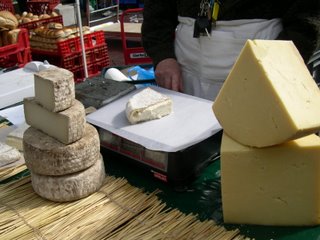
Back to cheese talk.
Most folks don't think about the history behind that block of shrink-wrapped, orange cheese they just brought home from the supermarket. Cheddar originated in Somerset County in England's West Country. There is a town called Cheddar which is close to the Cheddar Gorge and the Cheddar Caves (not much cheese is made in cheddar anymore but there is a touristy museum in the caves.) When you make cheddar, you must cheddar your curds. This is a process of stacking up your curds into loaves and letting the heat that they generate aid in the whey expulsion and acid production. Every ten minutes or so, you flip your curd loaves and let the top part cool and redistribute the moisture. The curds are knitting themselves into a texture like cooked chicken breast. After you cheddar your curds, you must mill them.
A couple of weeks ago, I was slinging the cheese back at La Lecheria de las Vaqueras and what should I spy, but a lone piece of my favorite cheddar on the planet. We had Westcombe Cheddar! Hallelujah! After I wiped my silly grin off of my face I had to ask everyone behind the counter if they had sampled this little beauty. It is one of the BIG THREE traditional farmhouse Somerset cheddars. The others are Keen's and Montgomery's cheddar. Each cheddar has its unique signature flavor, and is as individual as my three cats' personalities. All three are aged at least 18 months before we see them over here. I love Westcombe because it's has a slightly dry, crumbly texture and sweet toffee notes, even hints of butter brickle, yet it's still savory and warm on the tongue. I brought a sliver home and shared it with Jim. He was as thrilled as I was to see it. Together, we broke off a piece to taste. He took a sniff. Then he popped it into his mouth. "Oh my God!" he crooned. "It smells and tastes just like their aging room! I'm transported right there, to that huge room again!" It's true. You could totally smell that moldy, humid, cavernous warehouse in Somerset. This is a good thing.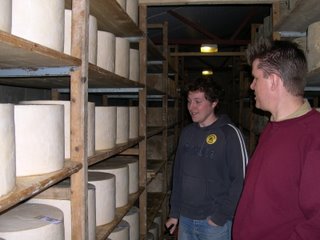
Jim and I visited Westcombe in May. Tom Calver spent half a day with us, showing us their facilities and the family farm. His dad runs the dairy while Tom takes care of the marketing end of the business. Tom was a superb host. We watched Bob, their cheesemaker preparing to make another batch of cheddar. Tom explained how they incubate a mother culture overnight to get a better starter for their cheese. This culture looks like yogurt when its ready to go. According to Tom, they even eat it like yogurt occasionally. He brought us into their aging room which is a three story bunker filled with thousands of wheels of cheddar and Westcombe Red, a raw milk red Leicester. The smell was of earth, mold, and cheese. Tasting that bite of Westcombe brought us right back to this room. The care and nurturing that these cheeses go through really impressed me. It begins with the cows. Tom wanted to show us something. We piled into his Mitsubishi SUV and drove up to the summit of a high hill. We got out of the car and were swept away by both the blustery wind and the panoramic view that encompassed miles of southern Somerset. In the distance was the Glastonbury tor, farms, small clusters of houses, the village of Evercreech, and his family's own farmhouse. But he wasn't just showing us the very impressive view. It was what we were standing in. All around us was knee high rye grass being tossed by the wind. Tom bent down and plucked a stalk. He told us that it's at its peak in nutrients and energy right now and is ready to harvest but they can't in because it has been too wet. It's true, it was raining a lot. This energy packed rye grass as well as the grass from the pastures helps the cows produce high quality milk. This in turn makes a damn, fine cheese. The care the cheese gets in the aging room, just seals the deal. I knew I liked their cheese, but after a day with Tom and his family, I LOVED their cheese. It's a reflection of their care and concern to make the best cheese that they can produce.
Posted by
Sairbair
at
7:34 PM
1 comments
![]()
Tuesday, August 15, 2006
Sebastopol then and now

It's August and I've got a gravenstein apple tree in my garden ready to offer up it's tasty burden. It's an early apple, slightly tart and sweet, crisp and juicy. It makes heavenly applesauce, superb apple cakes, amazing apple pies, and yet it's still a beautiful eating apple. When we were looking at houses, the apple tree was loaded down with fruit, even though it had obviously been neglected. This gravenstein tree was a major selling point in my mind. For the past decade, I can't find these apples at the grocery store. Unfortunately, the gravenstein apple orchards in Sonoma County, particularly in Sebastopol are rapidly vanishing. They are being ripped out and replaced with either vineyards or houses or both. What is a farmer supposed to do when the land that they've always cultivated is now worth millions of dollars per acre and they are only getting $0.20 per pound for an apple harvest that lasts for a couple of weeks? Wine grapes make money, apples don't. The land itself can give a quick, one-time payoff and the landowner can retire in style so long as they don't want to live in the Bay Area anymore. I can't blame the landowners for not keeping the trees, but I sure miss seeing our local harvest at my local grocery store. (Stepping off of my soapbox now.)
There's always been a soft spot in my heart for the area around Sebastopol in Sonoma County. We spent many Sunday drives tracking down seasonal fruits and vegetables. If we found a local treat, we'd usually buy some to take home. Honey, eggs, beef jerky, zucchini bread, parakeets, etc. This is Mr. King, as I mentioned in my first post, he's the extraordinary man who could grow anything in the fruitful soil on Ross Station Road in Sebastopol He's holding some of his tasty red potatoes. He's long gone now, but I hope his fruit trees have survived. 
Posted by
Sairbair
at
1:29 PM
0
comments
![]()
Labels: Cowgirl Creamery
Monday, August 14, 2006
I brake for Watermelon Trucks
Warning! No cheese content, but plenty of other food references!
My dad was a fan of the road trip. Why fly when you can drive, even when your destination is 1000 miles away? Gas was cheap and The Toad had a big gas tank. We could go for miles without stopping. And he would. We’d drive from the Bay Area to
One of my sisters went to college at Whitman in
One summer, we decided to drive east from
After a few days hanging out with my sister, we headed east on a scenic country highway. The scenery changed from wide open wheat fields to vast evergreen forests, narrow valleys, rushing rivers, and huge mountains. We crossed the
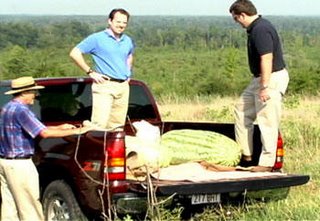
Posted by
Sairbair
at
8:24 AM
0
comments
![]()
Labels: Cowgirl Creamery
Thursday, August 10, 2006
Don't look back
I am amazed at the circuitous path my life has take me to get to where I am today. My current job situation might have sidetracked me before, but today it seems to be confirming that I am on the right path but the only way I could have gotten here was to take the long and winding road.
I've since college I've worked at four commercial radio stations, two record stores, a music booking agency, a large concert promoter, a comedy club, a dot com, an art college, a large conservation organization, a cheese shop and cheese factory, and a small environmental non-profit. I'm sure I'm missing a few things and I'm not counting short-term and one-off gigs. Even I look at my resume and am astonished at how I've been able to jump fields and careers. But somehow their all linked by one thing: my overwhelming drive and desire to do something I love. I am very passionate about my work and what I contribute to the world. So it all makes sense to me.
Since mid-June, I have been helping a non-profit as an interim office manager/project administrator. After our 18 day tour of
If I had found this job two years ago, I would have been thrilled, and my future would look very different, I believe. Even though the folks at Suscon all great people, and the work they a’re doing is truly inspiring, my heart isn'’t in it anymore. As they say, you can'’t go back. I a’m having too much fun moving forward. It's been great being involved in this organization and perhaps I can rope them into helping the cheese industry. Such as finding more ways to dispose of whey and make money doing it, but that'’s a conversation to be raised in the future.
Ten more days and counting....I hope this no liquids and no laptops and no books on airplanes relaxed before Aug. 20th. If not, it's going to be the longest flight ever.
Posted by
Sairbair
at
2:54 PM
0
comments
![]()
Labels: Ticklemore Cheese Devon England
Tuesday, August 08, 2006
Ticklemore

Do your surroundings effect your output? I wholeheartedly say "YES!" Take a look at the view out the front door at Ticklemore. It's only two miles from town, but it's a world away from the craziness of the material, superficial world that I see around me in San Francisco. If I want to make cheese, I want to find someplace like this. Robin keeps it simple. He buys his milk from dairies in Devon and Cornwall. He doesn't own a single animal. His sage advice, "If you want a life, and want a vacation once in a while, don't have farm animals." I'm inclined to agree with him. I love to travel. I can't travel and have sheep, goats or cows. Smart man, that Mr. Congdon.
Posted by
Sairbair
at
9:51 AM
0
comments
![]()
Labels: Ticklemore Cheese Devon England
Monday, August 07, 2006
Getting Ready for Devon
Where am I going? Where is all of this cheese stuff taking me? I'm learning all that I can in order to start my own creamery. I want my own cheese company. I love the craft. I feel totally at home in the cheese world. I swear, 75% of my thoughts are currently devoted to cheese. How did they get this texture? I wonder what starter they used? I wonder if they'll show me how they did that? I don't want to re-invent the wheel, so I am trying to be like a sponge, soaking up as much knowledge as I can. In two weeks I leave for England again. I am returning to Ticklemore, a cheese company in Totnes, Devon, England. I will be making cheese and house-sitting for Robin Congdon and his partner Sarie Cooper. You bet I'm nervous. It's like someone has handed me the keys to an 18 wheeler and said "You drive!" Sure, I've studied the manual, I've taken driver's training but now I've got to fly solo. Yikes! I can't wait to see what happens.
Totnes is a beautiful Elizabethan market town on the River Dart. Ticklemore is on a hillside, two miles outside of town. The place is "rustic." I'll be staying in their one bedroom apartment that's attached to the creamery. It also serves as the employee breakroom. Robin is letting me use their van, so I be able to get to town and tour around the countryside. The other cheesemakers, Nick and Ben will be there to help me learn the craft. We talked all about music and concerts when we spent the afternoon at Ticklemore in May. Should have lots more to talk about when I return.
So now I must start to pack. I should also look for some cables so I can connect my laptop to whatever I find. Robin doesn't have a computer. This should be a interesting. I hope there's a good, free wifi hotspot in Totnes.
Posted by
Sairbair
at
1:09 PM
0
comments
![]()
Labels: Ticklemore Cheese Devon England
American Cheese Society Conference, Portland, OR
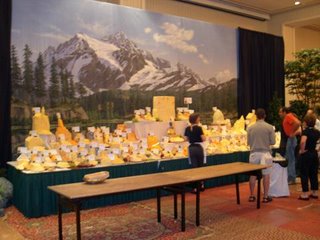
American Cheese Society Conference was a real eye-opening experience for me. I knew that the cheese world was populated by some nice folks. I've met some great people in the shop. I've visited a few cheesemakers and I have yet to meet anyone that's been unkind. There are more than a few "unique" individual, but like attracts like, y'know? At the conference, I observed a bunch of folks sharing ideas, building friendships, and trading experiences. It was a wonderful thing to see. There's a strong sense of community that is very supportive of each other, and I found it easy to meet folks that I wanted to meet. Like Mike Gingrich, of Uplands Cheese Company in Wisconsin, the maker of Pleasant Ridge Reserve. Sid Cook, owner of Carr Valley Creamery also from Wisconsin was great. David Gremmels and Cary Bryant were very warm and supportive to an eager, novice cheesemaker like me. I had a blast listening to Ig Vella, the owner of the Vella Cheese Company in Sonoma. His personal history is interwoven with California history and I just had to ask him a couple of questions to get him going. He's got a great family history, that reaches back several generations. Keep in mind he's in his 80's. I was entertained for an hour listening to his stories about going out with his dad, an Italian immigrant, and acting as occasional translator at the produce warehouses around San Francisco. His dad also sold their Dry Jack cheese as a substitute for Parmigiano Reggiano when it was unavailable during WW1 and WW2. They actually developed the Dry Jack in order to fulfill the demand for a hard grating cheese. Ig talked about how his grandmother(?) was the head cook for General Vallejo at his home in Sonoma. When Ig was a kid, there was a debate raging at a family gathering about what was General Vallejo's favorite meal. "Go ask Grandma!" someone said. Grandma wasn't there, but they called her up and asked her. (She lived to be 98.) Well, she settle the score with one word: ravioli! Apparently General Vallejo loved her ravioli. Being a local history buff, I ate this stuff up.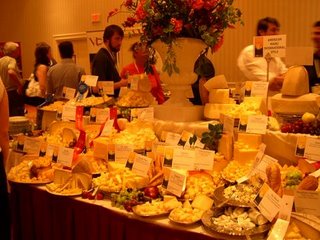
The Festival of Cheese was the grand finale of the conference. It was held in the grand ballroom at the Portland Hilton. Imagine a huge cavernous room filled wall to wall with tables of cheese. There were 941 cheeses on display. Everyone who entered the competition had cheese for sampling. I volunteered to do prep that morning. Aged sheep and fresh cheeses were on my table. Team of three tackled the immense task of setting up appealing displays of all of the cheese from the countless categories. There was a mountain of cheddar along the back wall. The conference had hired cheese carvers to sculpt birds and images on blocks of cheddar. There were seventeen tables set up with all of these cheeses. It was impressive. I got a pretty sore forearm from all of the cheeses that I cut up into bite-size bits. We began at 7am and preparations lasted until 3pm. At 5pm, the doors opened to the public.
My pick of the 941 cheeses? Aged Raclette by Leelanau Cheese Company of Michigan. It is rich, dense, chewy, with hints of smoky toffee flavors. I'd eat it all day long if I could. Sorry, you can't get it anywhere except at the creamery and winery. Ugh! Ann and John Hoyt are making some mighty fine Raclette up there in Michigan. They trained in Switzerland for four years and now produce their cheese at a farm that also has a winery and inn. Hmm. Perhaps I need to visit Michigan....
Posted by
Sairbair
at
11:36 AM
0
comments
![]()
Labels: Cowgirl Creamery

